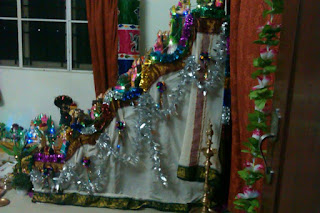The Bhagavad-Gita is one of the holy scriptures in Hindu religion. The slokas in it are the advice Lord Krishna gives to Arjuna (or Arjun) right before the Kurukshetra War in the Mahabharatha epic. These slokas are not only advice to Arjuna, but to everyone who reads the Bhagavad-Gita and listens to the advice Krishna gives us. They are lessons for life.
In Arizona, a family of Krishna devotees take Bhagavad-Gita classes for people who wish to learn it. Indian parents send their children to these classes and they themselves sometimes attend classes.
Saturday, December 10th, 2016 (the date changes every year, according to the Tamil calendar, which follows the stars), marked the yearly anniversary of the day Krishna imparted this holy advice to Arjuna. This class of Bhagavad-Gita students celebrated Geetha Jayanthi by presenting some slokas from each chapter with their meanings to the parents present there.
(P.S. I went to this event because my cousins are in this class and they were presenting and I JUST got my driver's license so I wanted to drive and my aunt and uncle let me!)
I took videos of the presentations! Unfortunately, there was something wrong with my phone so i could only take about 3 minute long videos, and that caused me to skip some parts f the presentation. But I'm posting the 13 videos I did take with whatever I captured and I hope you enjoy learning a litle about the Bhagavad-Gita slokas and what they mean!
In Arizona, a family of Krishna devotees take Bhagavad-Gita classes for people who wish to learn it. Indian parents send their children to these classes and they themselves sometimes attend classes.
Saturday, December 10th, 2016 (the date changes every year, according to the Tamil calendar, which follows the stars), marked the yearly anniversary of the day Krishna imparted this holy advice to Arjuna. This class of Bhagavad-Gita students celebrated Geetha Jayanthi by presenting some slokas from each chapter with their meanings to the parents present there.
(P.S. I went to this event because my cousins are in this class and they were presenting and I JUST got my driver's license so I wanted to drive and my aunt and uncle let me!)
I took videos of the presentations! Unfortunately, there was something wrong with my phone so i could only take about 3 minute long videos, and that caused me to skip some parts f the presentation. But I'm posting the 13 videos I did take with whatever I captured and I hope you enjoy learning a litle about the Bhagavad-Gita slokas and what they mean!







_in_Hyderabad_W_IMG_8736.jpg)





























